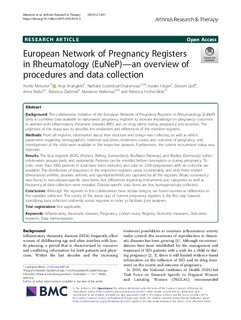| dc.contributor.author | Meissner, Yvette | |
| dc.contributor.author | Strangfeld, Anja | |
| dc.contributor.author | Costedoat-Chalumeau, Nathalie | |
| dc.contributor.author | Förger, Frauke | |
| dc.contributor.author | Goll, Doreen | |
| dc.contributor.author | Moltó, Anna | |
| dc.contributor.author | Özdemir, Rebecca | |
| dc.contributor.author | Wallenius, Marianne | |
| dc.contributor.author | Fischer-Betz, Rebecca | |
| dc.date.accessioned | 2020-02-19T08:31:46Z | |
| dc.date.available | 2020-02-19T08:31:46Z | |
| dc.date.created | 2019-11-19T11:27:52Z | |
| dc.date.issued | 2019 | |
| dc.identifier.citation | Arthritis Research & Therapy. 2019, 21 (241), 1-9. | nb_NO |
| dc.identifier.issn | 1478-6354 | |
| dc.identifier.uri | http://hdl.handle.net/11250/2642454 | |
| dc.description.abstract | Background: The collaborative initiative of the European Network of Pregnancy Registers in Rheumatology (EuNeP) aims to combine data available in nationwide pregnancy registers to increase knowledge on pregnancy outcomes in women with inflammatory rheumatic diseases (IRD) and on drug safety during pregnancy and lactation. The objective of this study was to describe the similarities and differences of the member registers. Methods: From all registers, information about their structure and design was collected, as well as which parameters regarding demographics, maternal outcomes, treatment, course and outcome of pregnancy, and development of the child were available in the respective datasets. Furthermore, the current recruitment status was reported. Results: The four registers (EGR2 (France), RePreg (Switzerland), RevNatus (Norway), and Rhekiss (Germany)) collect information prospectively and nationwide. Patients can be enrolled before conception or during pregnancy. To date, more than 3500 patients in total have been included, and data on 2200 pregnancies with an outcome are available. The distribution of diagnoses in the respective registers varies considerably, and only three entities (rheumatoid arthritis, psoriatic arthritis, and spondyloarthritis) are captured by all the registers. Broad consistency was found in non-disease-specific data items, but differences regarding instruments and categories as well as frequency of data collection were revealed. Disease-specific data items are less homogeneously collected. Conclusion: Although the registers in this collaboration have similar designs, we found numerous differences in the variables collected. This survey of the status quo of current pregnancy registers is the first step towards identifying data collected uniformly across registers in order to facilitate joint analyses. | nb_NO |
| dc.language.iso | eng | nb_NO |
| dc.publisher | BMC (part of Springer Nature) | nb_NO |
| dc.rights | Navngivelse 4.0 Internasjonal | * |
| dc.rights.uri | http://creativecommons.org/licenses/by/4.0/deed.no | * |
| dc.title | European network of Pregnancy Registers in Rheumatology (EuNeP)-an overview of procedures and data collection | nb_NO |
| dc.type | Journal article | nb_NO |
| dc.type | Peer reviewed | nb_NO |
| dc.description.version | publishedVersion | nb_NO |
| dc.source.pagenumber | 1-9 | nb_NO |
| dc.source.volume | 21 | nb_NO |
| dc.source.journal | Arthritis Research & Therapy | nb_NO |
| dc.source.issue | 241 | nb_NO |
| dc.identifier.doi | 10.1186/s13075-019-2019-3 | |
| dc.identifier.cristin | 1749287 | |
| dc.description.localcode | © The Author(s). 2019 Open Access This article is distributed under the terms of the Creative Commons Attribution 4.0 International License (http://creativecommons.org/licenses/by/4.0/) | nb_NO |
| cristin.unitcode | 1920,9,0,0 | |
| cristin.unitcode | 194,65,30,0 | |
| cristin.unitname | Klinikk for ortopedi, revmatologi og hudsykdommer | |
| cristin.unitname | Institutt for nevromedisin og bevegelsesvitenskap | |
| cristin.ispublished | true | |
| cristin.fulltext | original | |
| cristin.qualitycode | 1 | |

